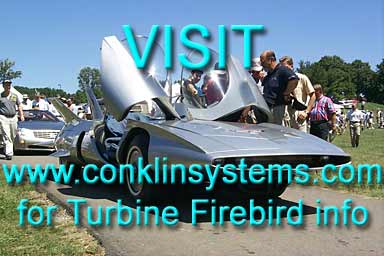
 |
Bloodlines |
![]()
| "It's in your blood." Heritage is a classic
and romantic notion that spans the globe. But at Conklin
Systems, we look back to a generation that, as far as we
can tell, laid down the seeds of R&D for generations. This is our Back to the Future, the legacy of Emmett Conklin. |
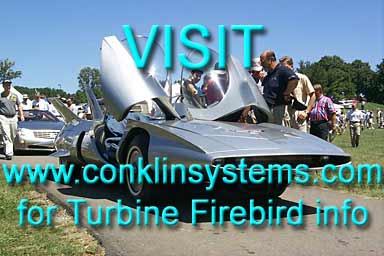 |
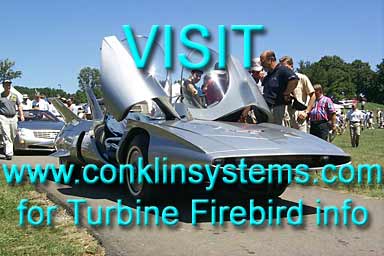 |
There was a time in America when good people were in
high demand, regardless. Emmett Conklin left school in the 9th grade to drive a truck for his father to help pay the family bills, and after got a job constructing the new G.M. Proving Grounds. |
| Initially, the job was digging roads for the future
Proving Grounds. After that, there was a job swapping
tires on test vehicles. Since the average tire of the day
only lasted 100 miles, and test vehicles were run 24
hours a day, swapping tires was a full time job. But in time, Emmett was able to upgrade to a test driver. This early picture, (around 1925,) shows him manning an analog paper-tape recording device. Ultimately, he got 'upgraded' to a test driver, and he drove a lot of miles in research vehicles. Trick was, research vehicles tend to break a lot. And a breakdown meant a five mile walk back, sooo, after a while people noticed Emmett's cars tended to come back changed, and for the better. Rather than walk back, he'd fix them himself, often with improvements. |
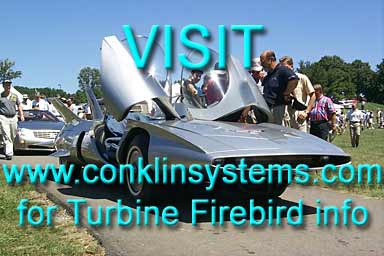 |
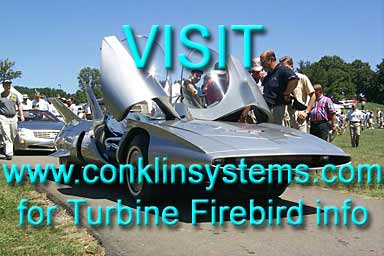 |
It didn't take GM long to realize that Emmett was a
Bright Boy, and he got promoted to a test track
supervisor. But then World War II got into full swing, and the entire world got drafted, so the test project became this 2-stroke, 4-cylinder aircraft engine prototype. This time, you can get it in GM's own words. (Apologies for the readability.) |
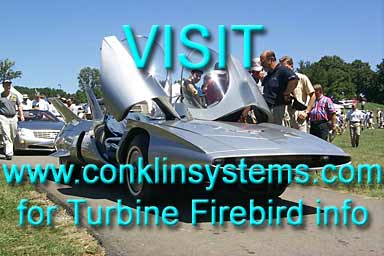 |
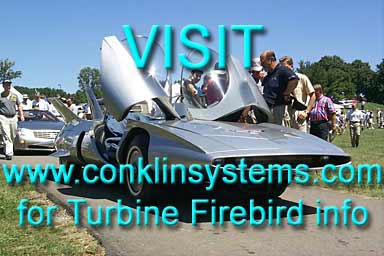 |
When the war was over, jet aircraft
and the turbine engine had just made their grand
entrance, and the world was interested. GM was
too, and the big question became "Are turbine
engines feasible for vehicles too?" The problem with a problem like that, is that when faced a totally new problem, all the schooling in the world won't help. It takes a certain natural instinct. And thus, GM's turbine research program became Emmett Conklin's project. |
| Welcome to the Firebird I, General
Motors first turbine vehicle. Emmett's second from the
right. The photo notes date this as December 17, 1953. When the Firebird I was first built, one of (the?) only people qualified to drive it was Emmett, who had test driving experience. So they rented Indianapolis Speedway for the day, took it down, and fired it up. The Firebird I, with its 370 HP GM-built turbine, only has 2 speeds, fast, and faster. Well, he got it up to about 100 MPH and shifted into second. Problem is, turbines have mountains of torque, so much the Firebird I broke the tires loose at that speed! Emmett decided "I'm too old for this #%^$&" and turned it off, so G.M. hired 2 time Indy winner Maury Rose to drive the car for a while. The Firebird I was recently on display at the Henry Ford Museum in Dearborn, MI. Here, 45 years later, is the modern day 'bird I in all it's glory. |
 370 horsepower - 2500 lbs! |
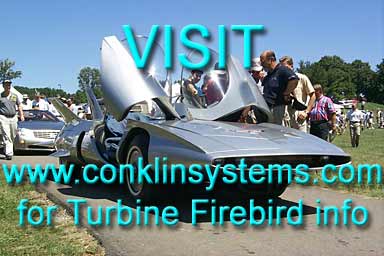
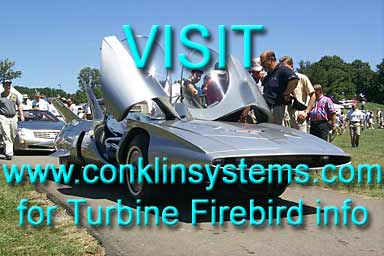 |
After building a successful turbine
vehicle, the next project was the Firebird II, a 4
passenger family vehicle. You can just hear dad say, "Well, dear, this'll get you to the store. |
|
However, changing plugs in the 'bird
II was a real pain. The Firebird II was shown at the 1956 Motorama. Check out the booklet that was passed out at that show, in its entirety.
 |
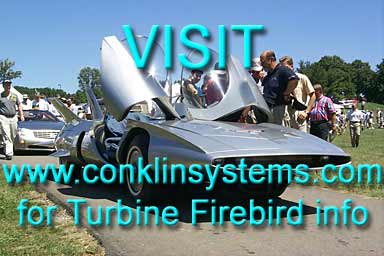 ` ` |
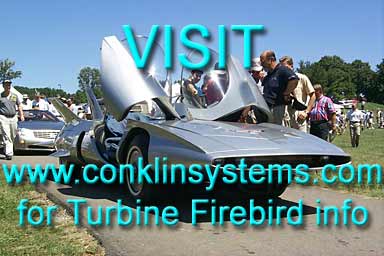 |
The 1959 'bird III was the final vehicle in the
series. By this time, it was an all-out prototype. It had
cruise control, an anti-lock braking system, and constant
temperature air conditioning - all features you can order
for your own vehicle now. It also had titanium skin (as did the II), an onboard computer that could drive the vehicle down a road by following a wire buried in it, and the control was a stick - forward for faster, back for slow, and left and right. So even now, 40 years later, not all the Firebird III's technologies are available. |
Emmett Conklin finally retired from G.M. after 46 years of service and raising a family of 7, many of which in turn worked for G.M. 30+ years. Spending a lifetime with a company, now there's an idea that died hard! Interestingly, this certificate was signed by Ed Cole, another lifetime G.M.'er known for his tireless backing of another advanced technology project, the Chevrolet Corvair, an aluminum engined, air-cooled, 6 cylinder rear-engined vehicle that was sold from 1959 to 1969. |
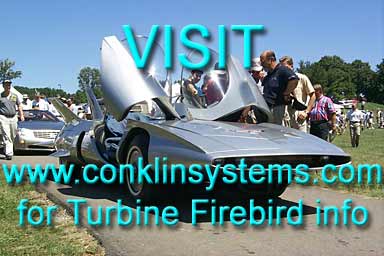 |
 |
It's said that no good man exists without the backing of a good woman, so the story wouldn't really be complete without a picture of Florence Conklin, who served as the G.M. Proving Grounds operator for 26 years. She was there long enough to memorize everyone by voice, and the numbers of people they typically called. After a while, people got into the habit of just picking up the phone and saying "Bill", because she'd know who it was, who they wanted, and the number. Eventually, the facility expanded and they hired another operator. And for a while, they'd grab the phone, say "Bill", and get "What am I, a mind reader?" or such from the new switchboard operator. |
| Even after retirement, Emmett Conklin
was always the engineer. And ultimately, he received U.S.
Patent #538,566 for his
Infinitely Variable Transmission and Control Apparatus.
Emmett died before he could
realize practical applications for his new transmissions,
but fortunately, he knew it was going to be awarded
before he passed away. And it was in this period that the loop was complete. Because Emmett needed calculations for estimated performance data, which his son Robert Conklin (Chevrolet R&D, w/G.M. 35 years) in turned explained in usable terms to his son Terence Conklin (Conklin Systems), who wrote a TRS-80 program to crunch the numbers. Have you thanked your parents today? Make something up. |
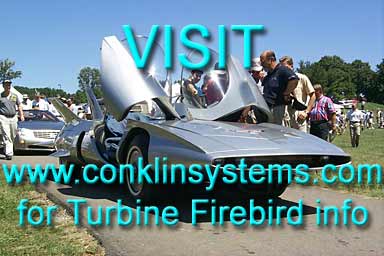 |
Questions or comments? Send them to
info2@conklinsystems.com
Conklin Systems 9905 Barnes Hwy
9905 Barnes Hwy Eaton Rapids, MI 48827
Eaton Rapids, MI 48827
Phone (517) 663-6418 Fax (517) 664-5802
Fax (517) 664-5802